Email Development
Inbox Insights 2023: The Email Developer Perspective

Email Development

Our friends and colleagues over at Sinch Mailjet released a new report that’s based on a survey of more than 3,200 email senders around the world. Inbox Insights 2023 is loaded with interesting information as well as actionable advice based on the results.
But there was so much data to unpack in the email marketing survey that we couldn’t include it all in one 75-page report. That’s why we decided to take a closer look at what the real email geeks had to say.
This article will explore some key insights from email developer responses. We’ll also compare the answers of email developers to a couple of other marketing roles. Let’s dig into the data…
Of the 3,200+ senders who participated in the Inbox Insights survey, nearly 350 respondents said their job role was best described as an email developer. More than 39% of those email developers say they are working in the United States. France (6.7%) and Australia (6.4%) round out the top three locations for email developers in this survey.
Around 11% of the email developers who completed the survey are working in the IT industry, and the rest of the respondents were fairly evenly spread across two dozen other industry options. More than half of the email developers in our survey work for B2C brands while a third are coding B2B emails.
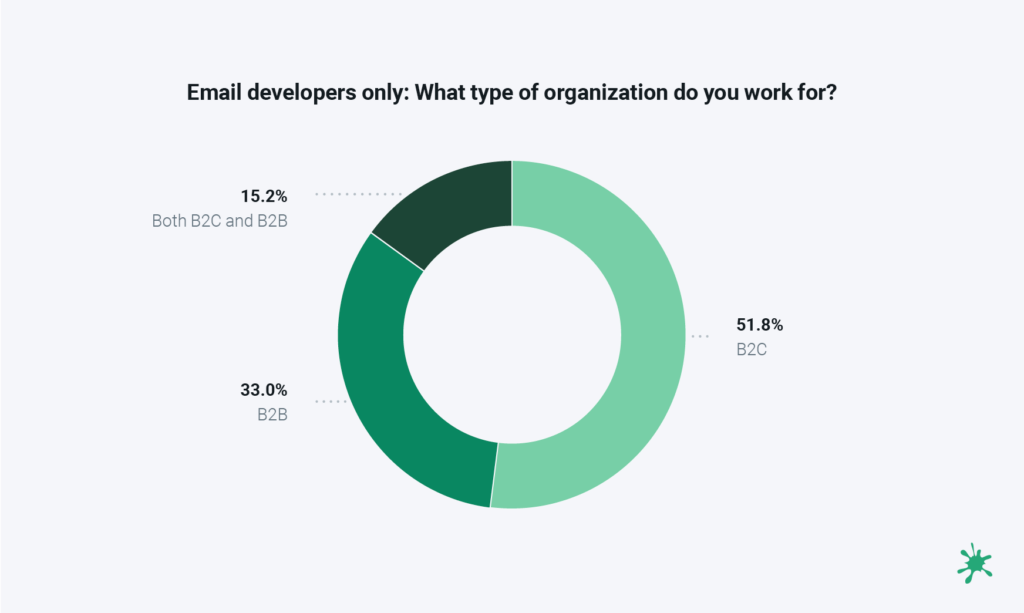
Survey participants also included those with IT and engineering roles, small business owners, lifecycle marketers, and general digital marketers. However, for the comparisons in this article we’re going to focus on email developers and two other job roles:
One thing we set out to learn with this survey is how senders feel about the success of email marketing and its impact on the business. The full survey (including all job roles and regions) found that just over 16% called email efforts over the last year Very successful. 43.5% said email was Somewhat successful and another 29% called their email success Average.
That leaves less than 11% who felt email was either somewhat or very unsuccessful. Not bad, right? And email developers seemed to fall in line with those numbers. However, when we segment and compare views on success, we can see that marketing leadership is a little less optimistic.

While email marketing specialists were more likely than developers to say their programs have been Very successful, leadership was more likely to call email Average or Somewhat unsuccessful.
Of course, a successful email program is one that gets the job done. So, what do senders expect email communication to accomplish? According to developers, the three most important email objectives are Content distribution (41.8%), Promotions and selling (35.1%), and Lead nurturing (33.3%).
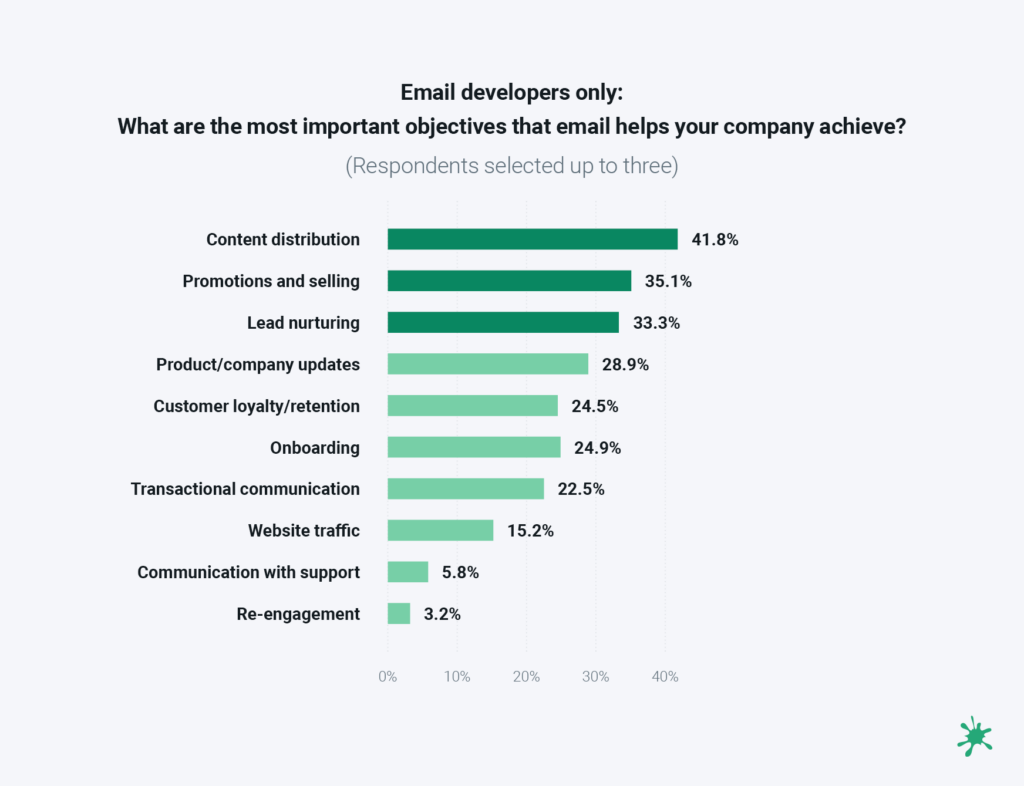
While email developers mirrored the full survey concerning content and promotions, there is one type of email communication they ranked much lower than average: Transactional communication. While just 22.5% of developers think messages like order confirmations and password resets are important, more than 35% of all respondents selected Transactional communication as a top email objective.
The truth is, transactional emails play a crucial role in customer experience and business success. They may not be flashy. But customers and subscribers expect to get them. While most transactional messages are pretty plain, it’s worth considering ways to improve transactional email design with your design and coding skills.
We also asked survey participants if they agree with the idea that email marketing makes a direct impact on business success. A similar story emerges here. Email marketing specialists are the most confident that their work is making a difference, developers are fairly confident, and more marketing leaders tend to be a little skeptical. More than a quarter of marketing leadership respondents (27%) somewhat or strongly disagree with the idea that email has a direct impact on success.
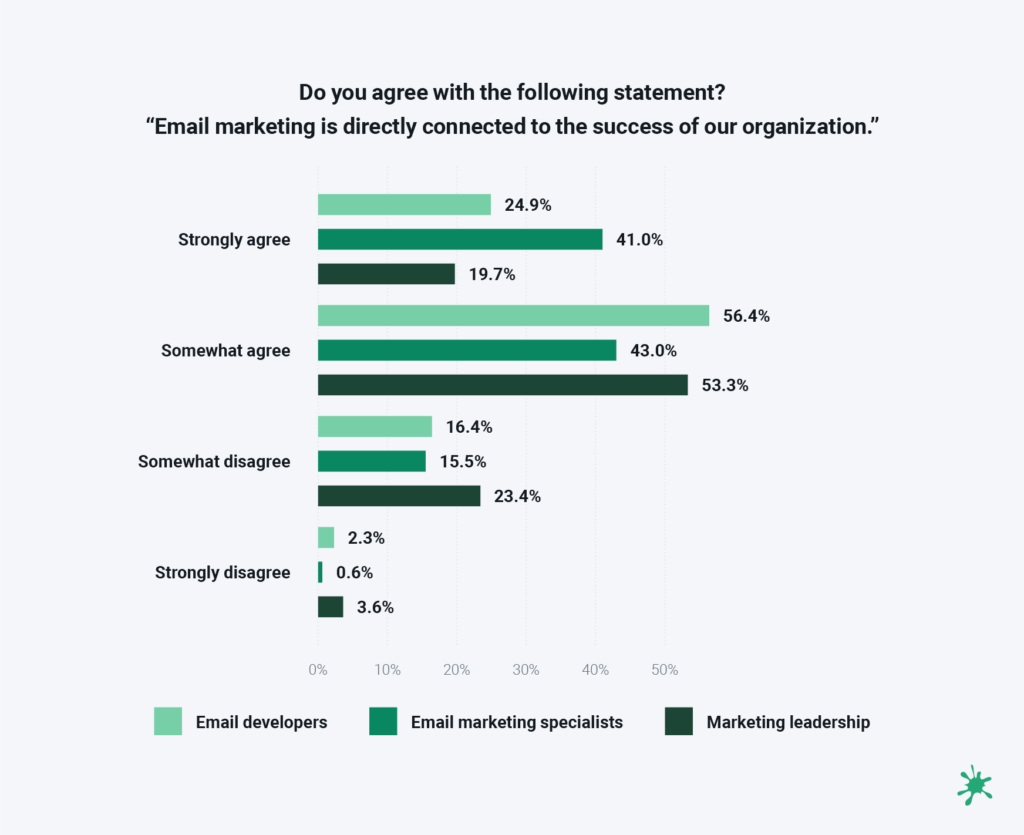
If you’re in a position where you know email is driving success, but you’ve got some doubters in the organization, you’ve got to find a way to illustrate email’s impact on business goals. That means you need hard numbers and the right email metrics.
The ability to measure email performance is crucial. Without it – how will you know what’s working, what needs to be improved, and what the true ROI of email is? When we asked senders around the world if they can accurately attribute the impact of email, 44% said “Yes.” However, that indicates more than half of senders are only capturing part of email’s effect on the business.
In general, those with marketing job roles of all types were more likely to report that they have a handle on email attribution. But once again, marketing leaders were not as confident as the email marketers and developers in our survey.
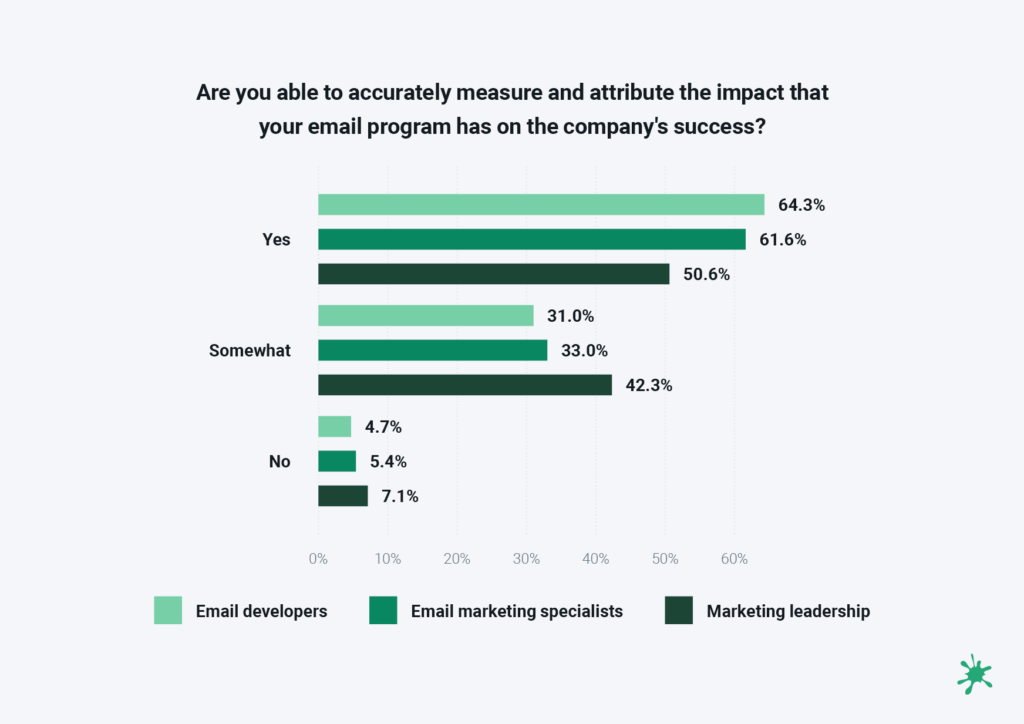
It’s interesting that email developers were the most likely to say the team can accurately measure and attribute email’s contribution to the company. Developers may not be constantly monitoring email analytics and writing reports on campaign performance. Still, email developers do care about the results of the campaigns they code.
Those numbers and results are the proof that all their hard work is making a difference. Email analytics show us how people respond to what we’re sending. You want to know what happens after someone opens an email. Which brings us to another topic: What email metrics are the most important for measuring success?
When given a list of 14 common metrics and asked to pick up to three, email developers made it clear that, for them, it’s all about the clicks. More than 42% of developers chose the clickthrough rate as a top metric. The rest of the top five metrics for email developers (open rate, revenue, CTOR, and delivery rate were selected just over 25% of the time.

While the other job roles agreed about the importance of clicks, marketing leaders placed a higher emphasis on email open rates. Email marketing specialists are more concerned with conversions and revenue while only 12.6% of developers selected the conversion rate as an important metric.
Interestingly, developers were more likely than others to select deliverability metrics as important. That includes the Delivery rate (26.3%) and the Inbox placement rate (22.2%). Email deliverability isn’t typically top of mind for developers. However, if campaigns don’t get delivered to the inbox, people can’t see the incredible emails they’ve coded. A campaign that gets filtered into spam represents wasted time and effort.

Developers also think email deliverability issues are having a negative impact on performance. Nearly 40%of the group chose Inbox placement issues as a major constraint to email program success.
Inbox Insights 2023 also explores where senders want to take email next and what stands in their way when it comes to success. First, let’s look at the advanced tactics senders want to implement and pursue in the coming year.
The tactics email developers selected are actually quite different than the results of the full survey. Among all survey respondents, the top three advanced tactics selected were Personalization (41.5%), Segmentation (35%), and Send time optimization (31.3%).
Email developers have a completely different top three. Those who code campaigns chose Preference centers (38%), Email authentication (36.5%), and Interactive content (33.9%) as tactics to pursue in 2023.
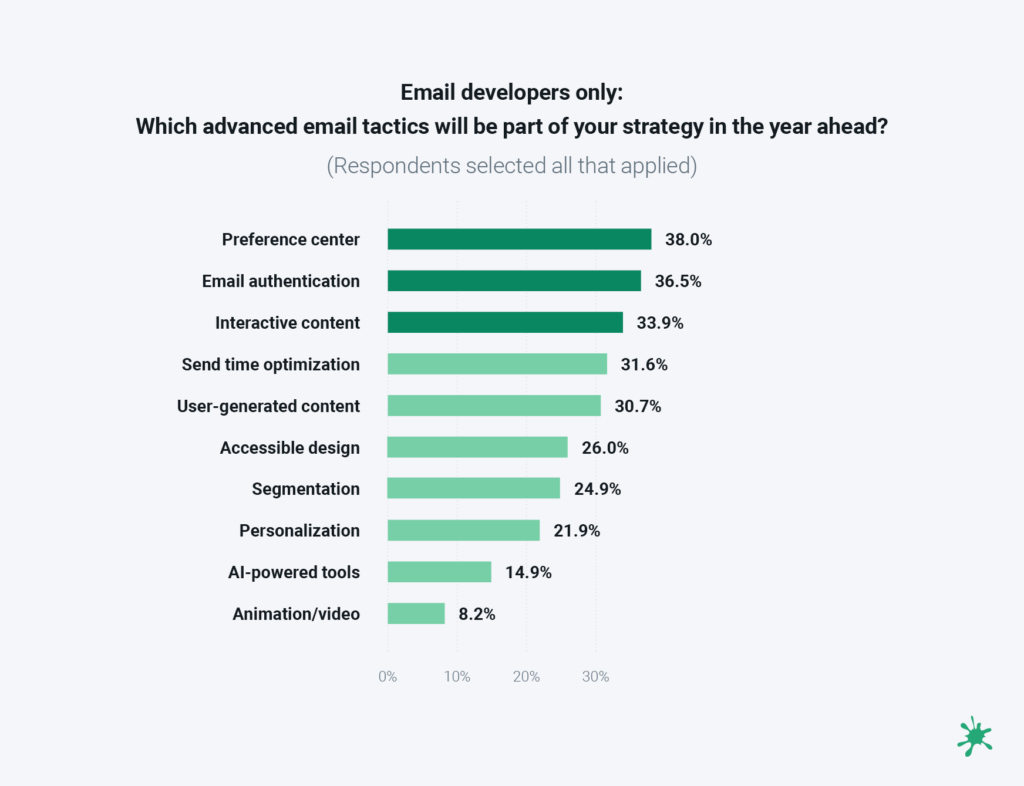
Email marketing specialists and marketing leadership roles mirrored the full survey because they also chose Personalization and Segmentation around 10% more often than developers. However, developers were more likely to say they’d be focusing on Accessible design this year.
Marketing leaders seem more interested in the idea of incorporating Animation/video into email campaigns. However, they may be unaware of the challenges that come with using animation and embedding video in email marketing.
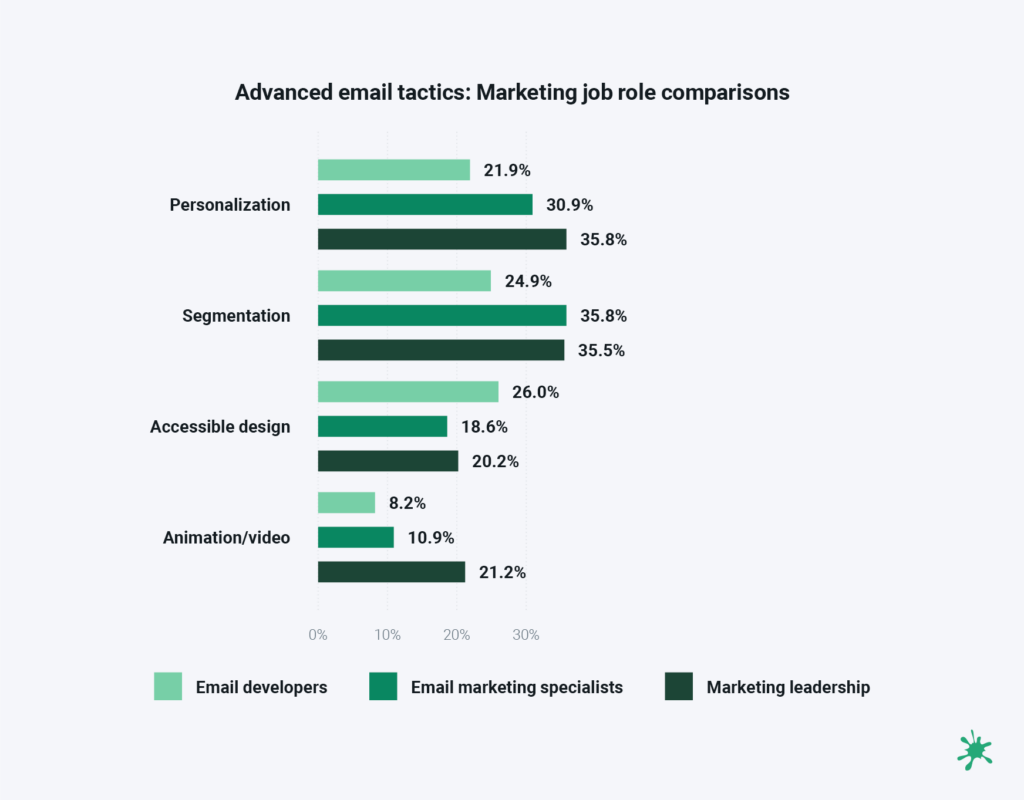
We can make some educated guesses about why developers have different opinions on this topic. One reason could be that only brands with more advanced programs employ dedicated email developers. And advanced email marketers would already segment and personalize. Regardless, those of who code emails for a living have a unique perspective. It’s fair to say that developers have a finger on the pulse of the email industry.
Personalization and segmentation are definitely important parts of a strong email program. However, they’ve also been around for a long time. Calling them “advanced tactics” may seem strange to those who think segmenting subscribers and personalizing emails are just part of the job.
On the other hand, preference centers are an effective and underused way to increase email engagement. It’s an approach that lets contacts tell you how often they want to hear from you and what they’re interested in receiving. Email authentication protocols are becoming increasingly important as phishing and brand spoofing are on the rise. Plus, adding interactivity to email campaigns is one of the best ways to stand out in crowded inboxes.
But speaking of standing out… It seems that email developers are a lot less concerned with this challenge than others. While Standing out in the inbox (37.3%) was the constraint chosen the most often among all job roles, less than a quarter of developers call that a problem. It didn’t even make the top five.
Instead, email coders think Inbox placement issues (39.5%), Lack of internal support/investment (37.1%), and Lack of time/focus (33.2%) are what stand in the way of success.
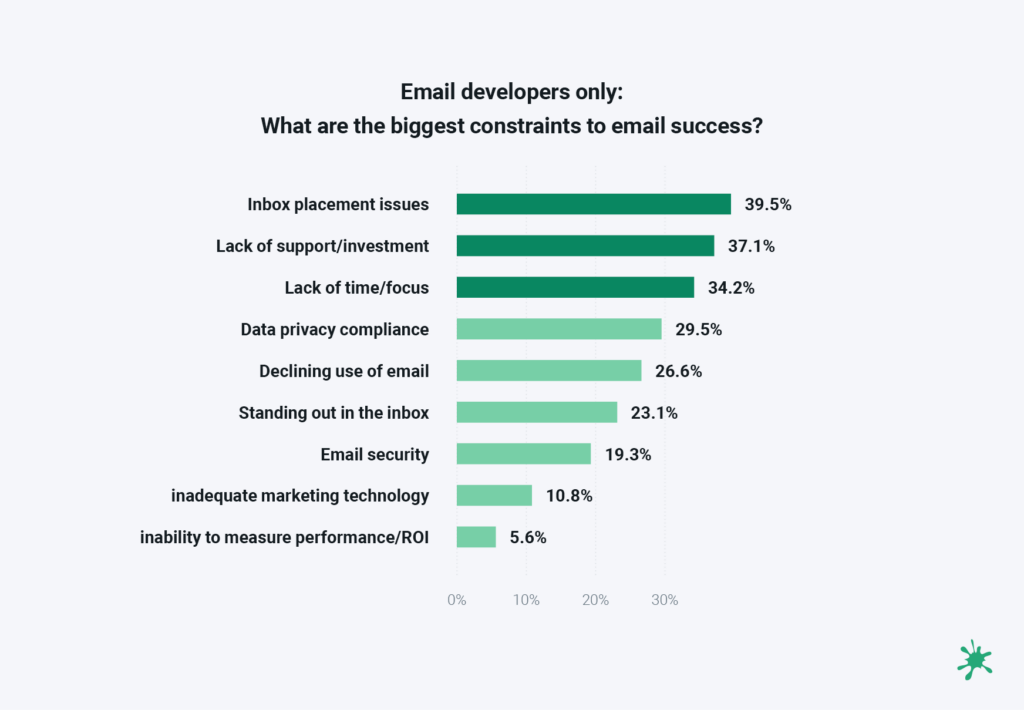
If you’re in marketing leadership or you manage email developers, listen up. They are saying they need more support and need more time to do their jobs effectively.
In fact, when we asked senders about how long it takes to launch a new campaign (email production time), developers were most likely to say the process should take at least a week or two. Email development is one of the last steps before a campaign is deployed. Sometimes, marketing teams spend a little too much time crafting their message and finalizing designs, which can put developers in a time crunch.
Of course, if time and focus are problems for your team, a component-driven email design system can make everyone faster and more flexible.
If you’re an email developer, we don’t have to explain how challenging the job is. Those challenges are the reason Sinch Email on Acid exists. So, the top three email design and development challenges that coders picked make complete sense.
Topping the list for developers is Responsive emails (41.2%). That’s followed by Dark mode emails (36.2%) and Inconsistent client rendering (31.6%).
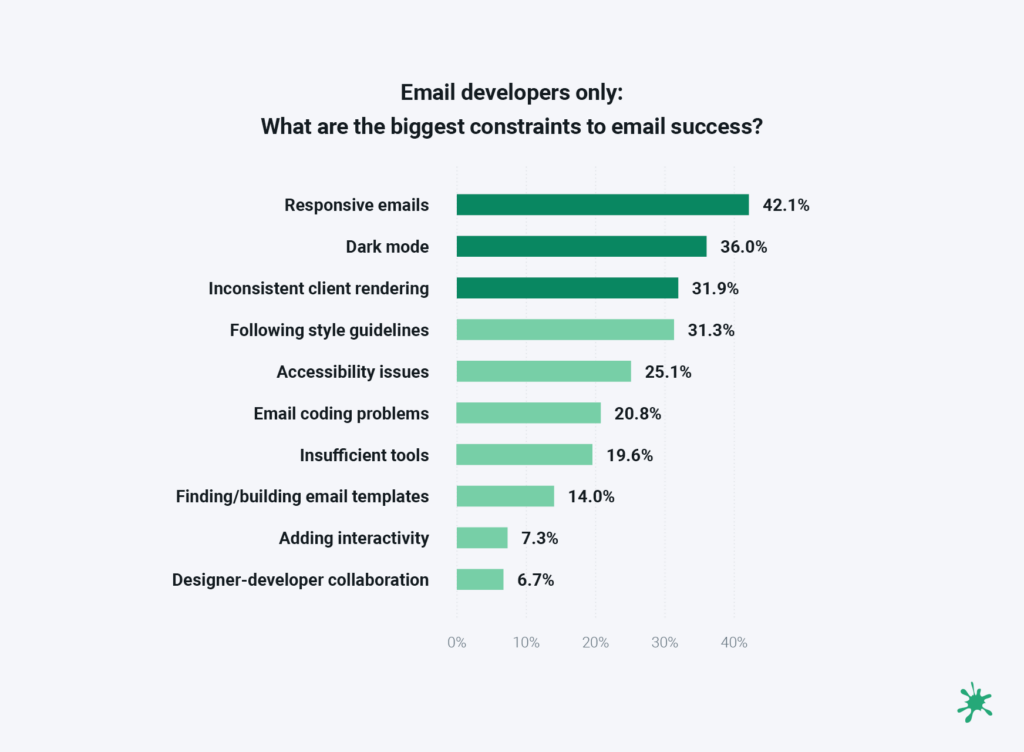
Here’s a bit of good news for email developers: The rest of the marketing team and others involved in sending email feel your pain. The same three email design challenges top the list for all respondents as well as for email marketing specialists and marketing leaders.
However, a closer look at other challenges does provide some interesting insights. For example, email marketing specialists are noticeably more challenged by Email coding problems (29.1%) than developers. That could reflect frustrating situations when a drag-and-drop email editor won’t do the trick and they need to tweak the code.
Email developers and marketing leaders see Following style guidelines as a bigger issue and both groups think Insufficient tools are more of a problem then email marketing specialists do. But developers do not view Adding interactivity as challenging as the other two job roles feel it is.
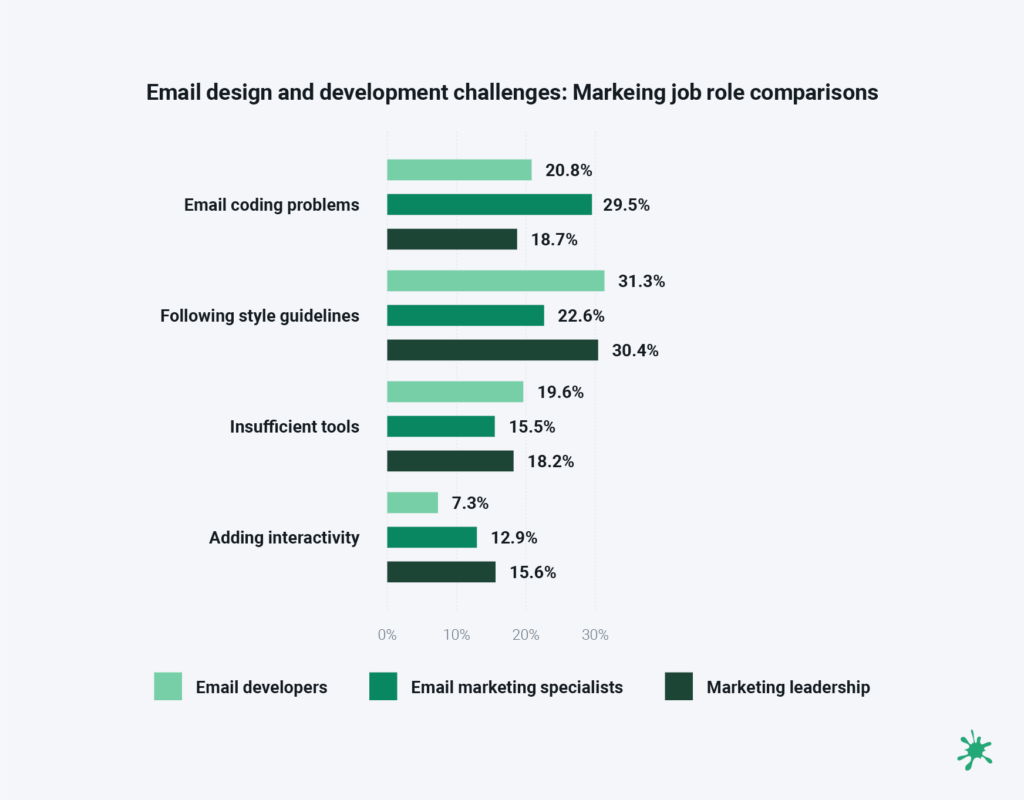
While these challenges aren’t going anywhere anytime soon, Sinch Email on Acid is dedicated to helping simplify email marketing with a pre-deployment platform that makes quality assurance and testing effective and efficient.
Email on Acid’s email previews show you how campaigns render on more than 100 different clients and devices. That includes dark mode email previews and screenshots from the most-popular smartphones. Test as much as you need with Email on Acid. Unlike others, we offer unlimited previews with every plan. Plus, our team management features make review, collaboration, and approval extra easy.
Start taking on the challenges and improve your chances of success when you put your best email forward.
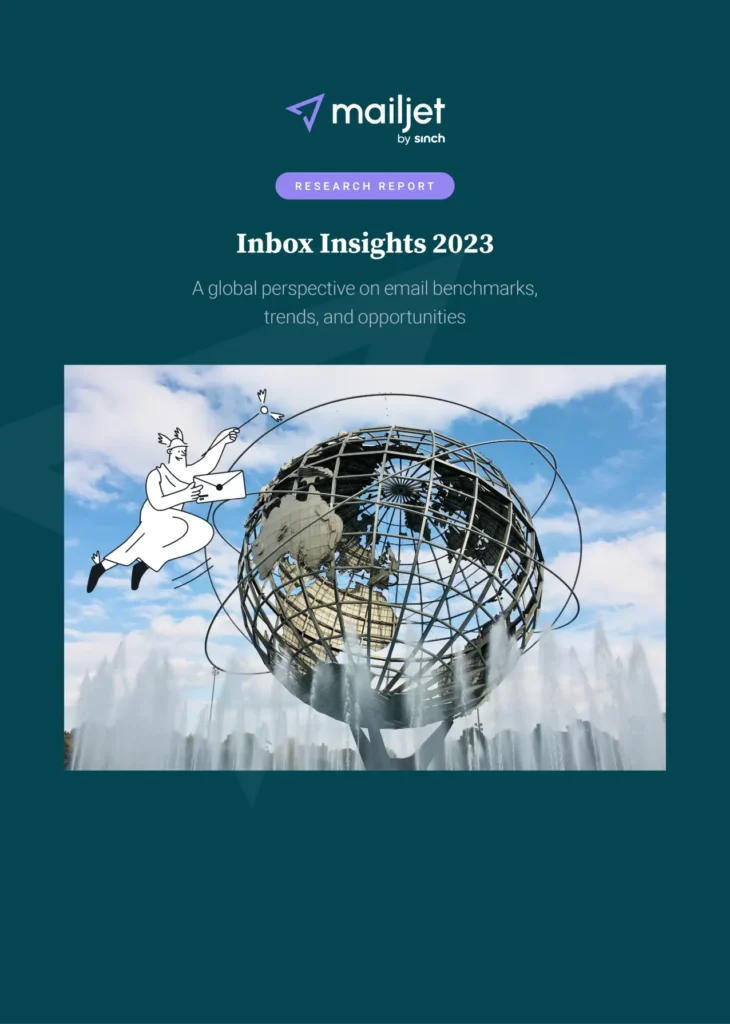
Don’t miss the rest of the results from our global survey of email senders. Inbox Insights 2023 explores the state of email across regions and industries.
In the full report, you’ll find: